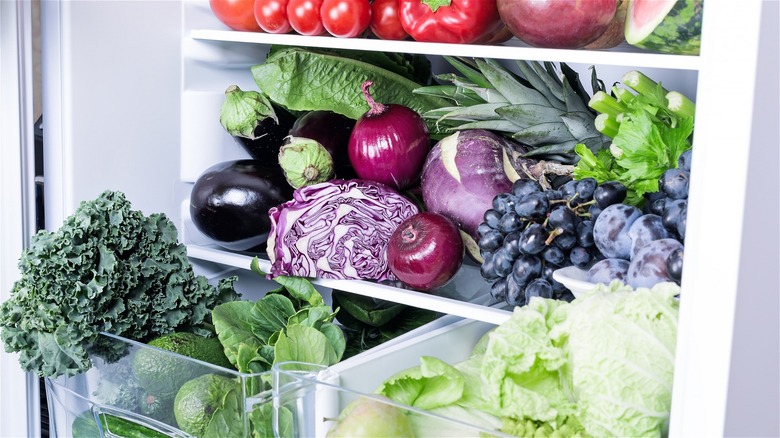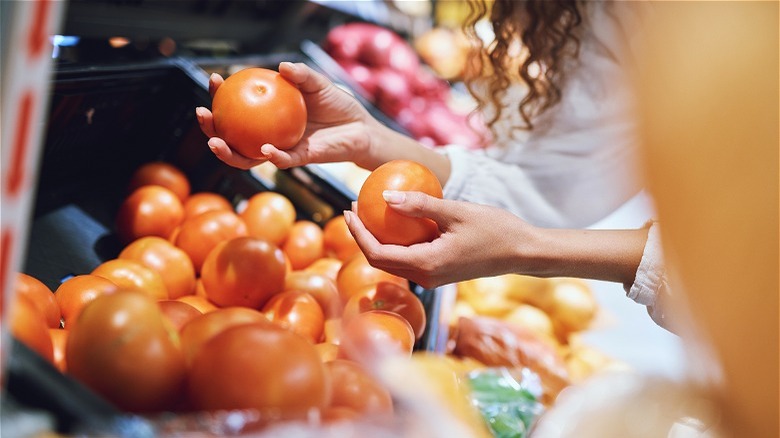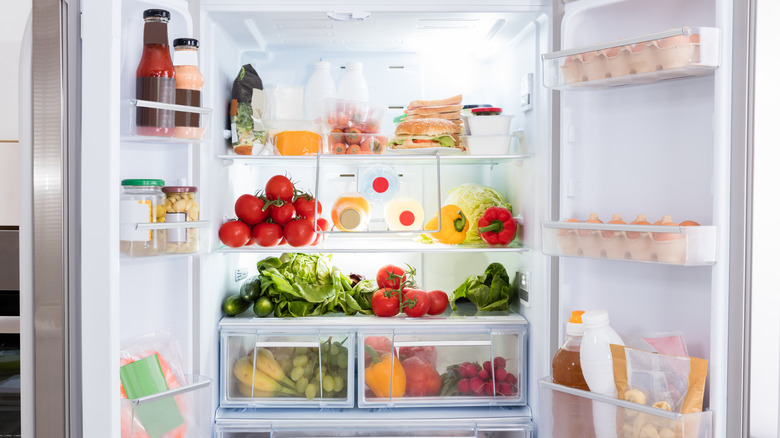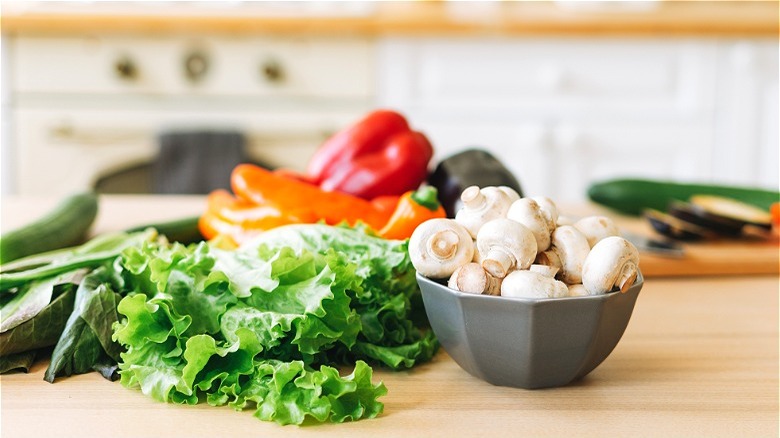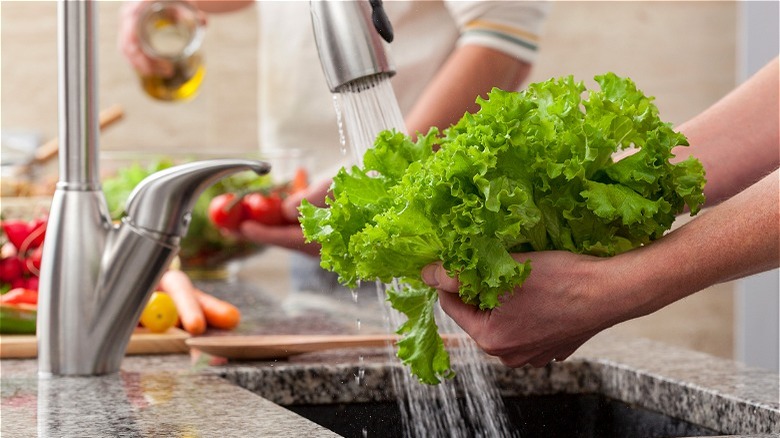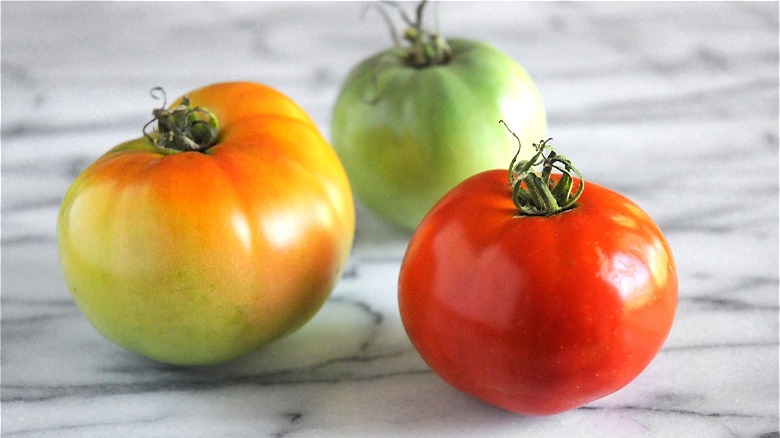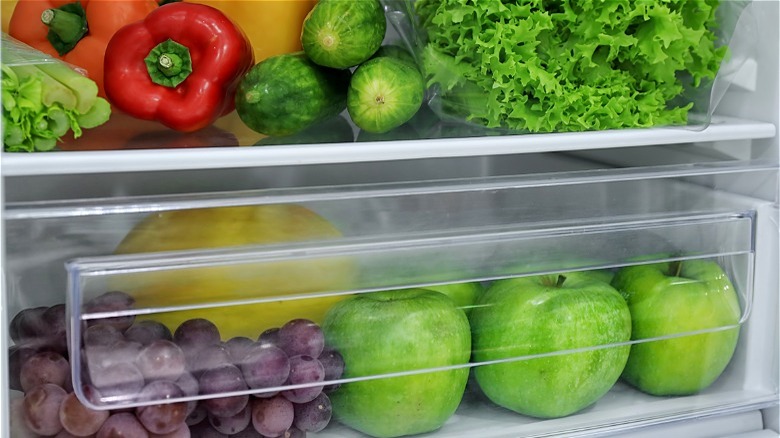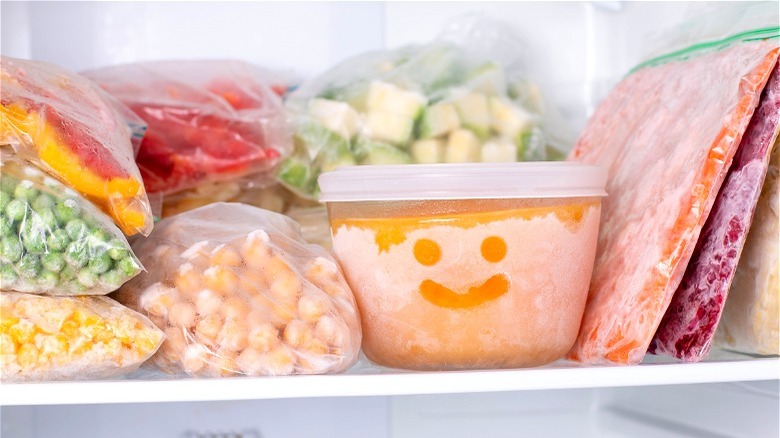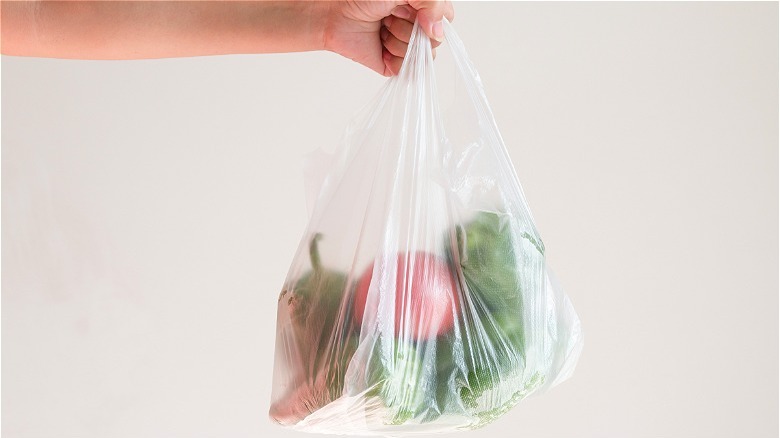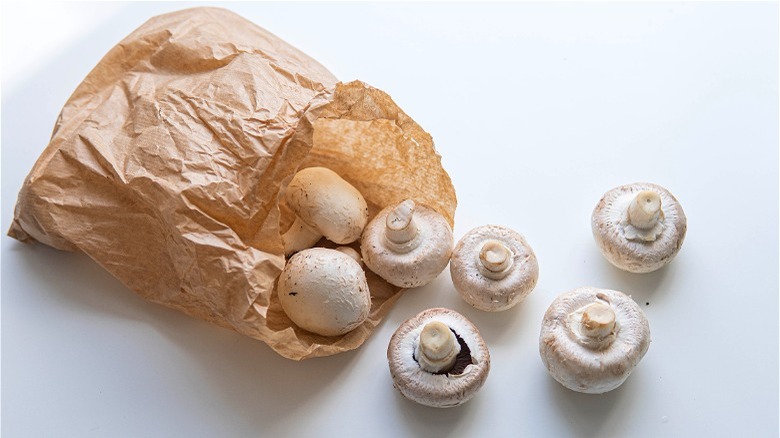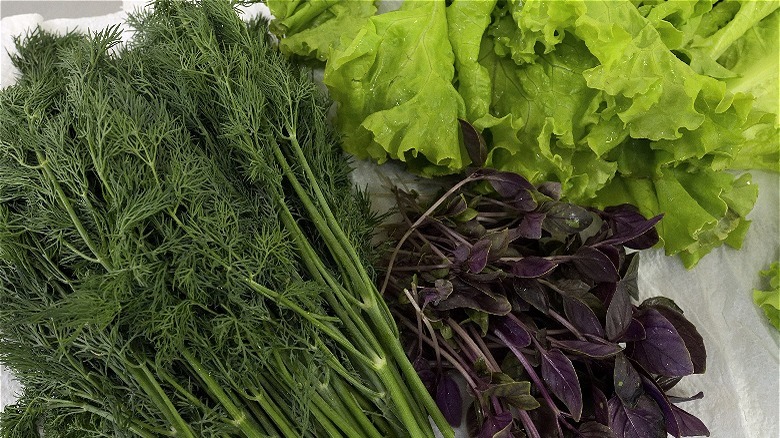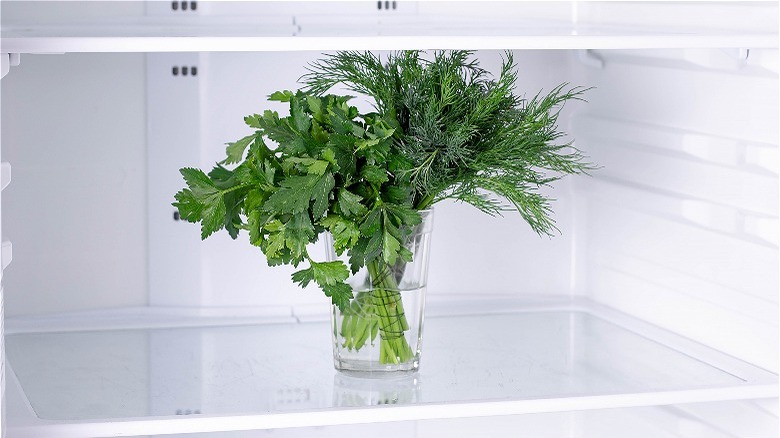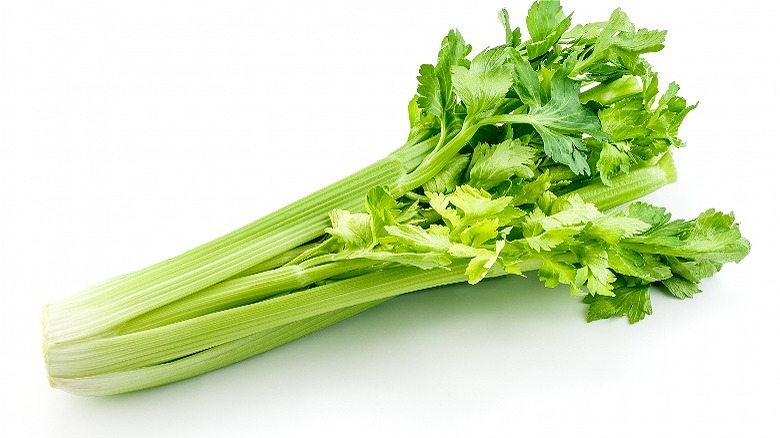Hacks That Will Keep Your Vegetables Super Fresh
There are few things worse for a home cook than peering into your fridge and discovering that your produce has gone bad. You might find that your mushrooms are slimy, your celery has become soft, or your kale is turning yellow. Some of us look upon these signs of decay with ease, willing to eat them to prevent food waste. This is usually not recommended, since it could make you sick. More risk-averse people will sadly place the produce into the trash or compost bins with regret. But it doesn't have to be this way.
How long each vegetable lasts varies. Things like tomatoes, asparagus, broccoli, spinach, and corn will stay fresh for a matter of days. Other veggies — like potatoes, beets, peppers, and rutabagas — can last for a week or two (if you're lucky). Some even say that carrots can last an entire month (via UnlockFood). However, none of this will happen if you don't store your vegetables properly.
Keeping your vegetables fresh requires several steps. These tricks aren't exactly time-consuming, but we'd venture to guess that not everyone is doing them. Some of these hacks are also counterintuitive, meaning you may be doing the exact wrong thing for your produce without even knowing it. This all means that learning to do the right thing could be extremely beneficial. It could help you save time at the grocery store, as well as money spent on expired goods. To learn the best hacks for preventing food spoilage, read on.
Choosing fresh produce to begin with
Selecting perfect produce is the first step to long-lasting vegetables. This is because damaged goods may already be on their way to spoiling. Since there is already so much room for user error in storing vegetables, we recommend starting strong. One way to do that is by shopping seasonally. Another way to choose the best produce is by shopping locally.
Most importantly, you should make sure each vegetable is in good condition when you buy it. There are different signs of freshness to identify in different vegetables (via How to Cook). Potatoes should be firm, smooth, and even-toned. Avoid sprouted or green ones. Beets should be firm and relatively smooth-skinned, per Gardening Know-How. Onions should be heavy for their size, with flaky skin and firmness all around. Mushrooms should be dry and smooth. Brussels sprouts should appear a vibrant green. Asparagus should be plump and green. Broccoli should have buds that are tightly wound together.
This is by no means every vegetable out there. This doesn't even account for fruits commonly mistaken as vegetables — like tomatoes, avocados, peppers, cucumbers, peas, green beans, eggplant, corn, zucchini, and more (via Business Insider). But for the most part, you want to avoid a few key signs of spoilage. These include slime, bad smells, mold, discoloration, or textural changes (like sudden softness), explains The Homesteading Hippy.
Starting with a clean and organized fridge
You'll also want to make sure your canvas is ready for action. That means having a kitchen that is clean and organized, and your fridge is of the utmost importance. There are endless ways to go about preparing your fridge, but it's probably best to start by doing a deep clean. This part may sound especially annoying, but don't worry; most people only recommend doing this step every three to four months (via Molly Maid). When you do, take everything out, get rid of expired products, and wipe down the inside with cleaning materials. Finally, you are ready to start putting things back in there.
Feel free to organize your fridge based on what's most fitting for your lifestyle. There are no hard and fast rules in this department, only tips that may help to optimize your kitchen use and organization. Per MyDomaine, you can sort your fridge into food categories, purchase additional storage containers (including fridge drawers, shelves, lazy Susans, or drawer dividers), rearrange drawers and shelves to optimize space, label your containers, and get rid of store-bought packaging. This all will help your vegetables stored in the fridge stay especially fresh.
Removing some vegetables from store-bought packaging
You will need to take some of your produce out of its packaging. According to Martha Stewart, this needs to happen with all vegetables (and fruits commonly referred to as vegetables) that are stored at room temperature. This includes tomatoes, eggplants, potatoes, and onions. These vegetables need ventilation, so they shouldn't be confined by store-bought packaging like plastic produce bags. Other fruits and veggies don't necessarily need to be taken out of their packaging. This includes things like apples, broccoli, cauliflower, carrots, peas, and more. However, this last category is where things become tricky.
Fridge-stored vegetables shouldn't stay in their store-bought packaging if that packaging is airtight or plastic. According to HuffPost, that's because fridge-stored vegetables also need room to breathe. However, there are even more things to consider with this step. Per The New York Times, if your fridge vegetables were stored in reusable, mesh produce bags, then it may be okay to leave them in these containers.
Preparing your veggies for storage
In the world of produce storage, there are a few disagreements. One is over whether or not you should wash your vegetables immediately after bringing them home, or if you should wait until right before you are about to eat them. As the University of Connecticut explains, the disagreement comes from the risk of putting slightly wet vegetables into the fridge, where they may be more likely to form mold or bacteria due to dampness. If you're going to wash your vegetables just after bringing them home, make sure they are completely dried before putting them in the fridge. This is one way to avoid a common vegetable-prepping mistake. Also, you do not need to wash pre-washed ingredients.
Another common dispute concerns whether or not you should cut vegetables before storing them. People will recommend that you chop up or cut your veggies days in advance to save time. Although this may slightly shorten your weeknight meals, we do not recommend it. For one, produce loses some of its nutrients when cut, explains Verywell Fit. You'll usually get fewer nutrients from pre-cut produce as well — but not with frozen pre-cut produce. Additionally, cutting your vegetables before storing them can lead to oxidation in some plants. Chopping up potatoes, bananas, apples, parsnips, or eggplant causes their color to change. Oxidation doesn't mean they will make you sick (via Step to Health), but these color changes can make the food look unappetizing.
Knowing which vegetables don't go in the fridge
Once you've decided whether or not to wash your vegetables right away, it's time to think about where everything will go. There are quite a few vegetables (and fruits thought of as vegetables) that do not belong in the fridge. In some cases, these veggies will go bad faster if placed in too cold of an environment.
According to Treehugger, produce that doesn't need refrigeration includes tomatoes, potatoes, winter squashes (such as acorn and butternut squash), alliums (like onions, garlic, and shallots), and some things classified as "tropical fruits" (such as eggplant, cucumbers, and peppers). Then, there are types of produce like avocados that don't need to be left out of the fridge, but keeping them out will allow them to ripen faster. On the other hand, if you want to prolong the shelf life of your avocado, you can put it in the fridge.
Of course, there are still plenty of commonly refrigerated vegetables. These things either need near-constant refrigeration or their lives are prolonged by it. According to The New York Times, fridge-safe produce includes tubers and roots (like turnips, beets, carrots, rutabagas, ginger, and parsnips), some cruciferous vegetables (such as broccoli, cauliflower, and cabbage), and leafy greens (like lettuce or kale). These last longest when kept in the fridge.
Separating fruits from vegetables
While you're still thinking about the placement and organization of those vegetables, you should consider what items will be grouped. Some types of produce emit a gas called ethylene which can cause different pieces of produce to go bad faster. Per Business Insider, many ethylene-emitting pieces of produce are fruits. That's why, in general, you should keep fruits and vegetables separate wherever you are storing them.
Per UCSD Community Health, some ethylene-emitting produce includes avocados, apples, bananas, peppers, tomatoes, pears, peaches, kiwis, and cantaloupes. These items should not be stored near ethylene-sensitive produce, like broccoli, cucumbers, asparagus, carrots, cabbage, Brussels sprouts, eggplant, green beans, leafy greens, squash, sweet potatoes, and zucchini. Then, there is a third group of produce that is not ethylene-sensitive, meaning you can feel free to store them near ethylene-producing produce. This group includes cherries, berries, corn, garlic, and mushrooms. To extend the shelf life of your veggies, take ethylene into account.
Freezing vegetables that you won't eat right away
Instead of throwing your vegetables away, you can preserve them for later use. By doing so, you extend the lifespan of most vegetables from days or weeks to months. Per Runner's World, properly stored veggies can survive for eight to 12 months in the freezer. Unlike canned vegetables, frozen vegetables often retain most of their nutrients. According to Cleveland Clinic, bagged veggies you find in the freezer aisle may even have more nutrients than the fresh stuff, due to them being frozen at peak ripeness. While this may not always be the case with vegetables that you freeze yourself, having frozen produce on hand can help to boost the amount of plant-based foods on your plate.
Some vegetables that freeze best are carrots, peas, corn, broccoli, cauliflower, green beans, spinach, kale, and collard greens. These vegetables have a low moisture content, which helps them maintain their shape once thawed, according to The Washington Post. Vegetables with a high moisture content include radishes, lettuce, cabbage, cucumbers, and mushrooms. This category of produce will be mushy after thawing.
Another frozen veggie tip is to prepare your produce for its time in the freezer. Some people recommend washing, trimming, chopping, and then blanching your items (via Food for Net). Blanching is a cooking technique that involves quickly submerging food in boiling water before cooling it under cold water, explains Clemson. This process helps ensure safety and quality in the freezer.
Not storing your vegetables in plastic
Instead of simply popping your vegetables into any area of the fridge, it's best to do some additional packaging. Some might tell you to place your veggies in airtight containers like Ziploc bags or Tupperware. However, this is not usually the best method for keeping your produce fresh. As The Washington Post explains, most vegetables need some air exposure to keep them from spoiling. Placing them into tightly sealed plastic containers could make them go bad faster. When moisture is tightly sealed inside, this could be hastening the growth of bacteria. If you must use plastic bags, don't seal them all the way, or poke holes to let your vegetables breathe.
But there are additional concerns about using plastic bags — even those that you've modified for more ventilation. Some say that by placing your veggies in close contact with plastic, you could be helping potentially dangerous materials within the plastic to seep into your food (via NDTV Food). Instead, it's recommended to wrap your veggies in reusable produce bags made of breathable materials like mesh (via Martha Stewart).
Keeping some produce in brown paper bags
Some vegetables will last the longest when stored in brown paper bags. Per Paper Bag Co., this is because these sacks help to absorb moisture from vegetables that do best in dry environments. Vegetables that benefit from storage in brown paper bags include mushrooms, potatoes, and onions. According to Colony Co., you can also place tomatoes and avocados in brown paper bags. If you add an apple to paper bags containing these things, it will also hasten their ripening period.
Other vegetables do well in other types of bags. This is because of certain vegetables like more moist environments. However, this doesn't mean you should put still-wet veggies in the fridge immediately after washing. Instead, simply store these pieces of produce in containers that don't soak up a lot of moisture. For these, we don't recommend using brown paper bags or plastic bags. But if you don't have anything else on hand, a plastic bag will do. Produce in this category includes leafy greens, cucumbers, and asparagus, per Business Insider. According to White Picket Produce, cauliflower is also a part of this group.
Using paper towels to extend the life of certain vegetables
Throwing some paper towels into the mix can help to keep certain vegetables from going bad. This can help to regulate the amount of moisture released from produce during storage, which needs to happen because different types of produce require different levels of humidity during storage. Per Hunker, most vegetables need more humidity than fruit. Leafy greens, green onions, and cauliflower need high humidity during storage. According to Improving Life at Home, some low-humidity vegetables are onions, tomatoes, and peppers.
Paper towels can help with these humidity differences in various ways. Dry towels can be placed in bags with mushrooms to soak up excess moisture (via MasterClass). On the other hand, damp paper towels can be wrapped around things like cauliflower to increase the humidity of this veggie's environment. Leafy greens — like romaine lettuce, iceberg lettuce, kale, and spinach — also benefit from being wrapped in dry paper towels (via Everyday Cheapskate). Although these veggies generally require humidity, they also release moisture that needs to occasionally be soaked up by a paper towel.
Learning how to keep herbs from spoiling
Although you may have thought that herbs are in a category all their own, they're considered vegetables. Per Sunny Botanist, they are usually thought of as vegetables used in smaller amounts due to their higher concentration of flavors. Some common types of tender herbs are dill, mint, basil, cilantro, and parsley. These herbs are usually purchased fresh in large bunches. Preserving herbs like these usually takes a few extra steps to keep them from going bad.
Per MasterClass, there is one common method for storing tender herbs without freezing them: storing them like a bouquet. Trim any bottom bits off the ends, wash the herbs, dry them thoroughly, place them in a jar filled partially with water, and then cover the top of the herbs with a plastic bag. While storing in the fridge, you should replace the water with fresh liquid every few days. The only tender herb that is an exception to this rule is basil. Follow the aforementioned steps, but leave basil out at room temperature in a sunlit space. Basil should not be refrigerated.
Using aluminum foil to keep your celery and bananas from going bad
Brown paper bags, mesh produce bags, glass jars filled with water, paper towels, and plastic bags — these are some of the tools you'll need to keep your vegetables super fresh. But there is one other method we also recommend for extending the shelf life of your produce: the aluminum foil hack for keeping celery fresh. The aluminum foil allows ethylene (the chemical that can induce ripening in some produce) to escape from the celery instead of trapping it near the vegetable. This makes it a better material than plastic wrap, which traps the ethylene and speeds up the ripening of celery.
Using this trick is simple. All you have to do is cover your celery stalks in aluminum foil. To extend the life of this veggie even further, you can place a damp paper towel inside the foil around the celery, adding back additional moisture that the celery may need to thrive.
Per FoodHow.com, you can do a similar hack with bananas. Simply separate your bunch of bananas, apply lemon juice to the place where you've separated the fruits, wrap each stem in a small piece of aluminum foil, and then place the bananas in a part of your kitchen without direct sunlight. It may allow your bananas to last for up to 10 days.
